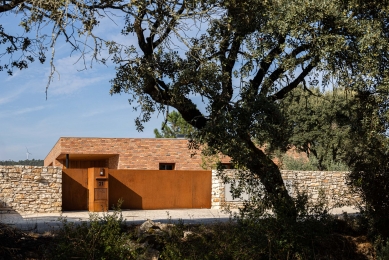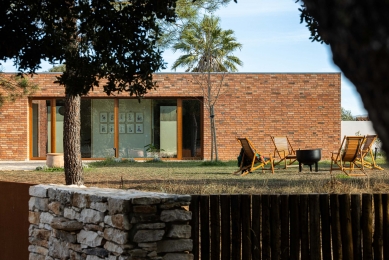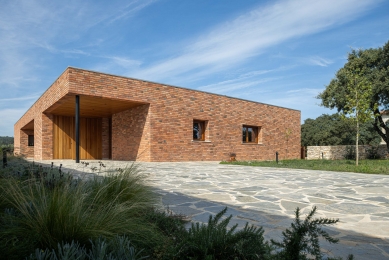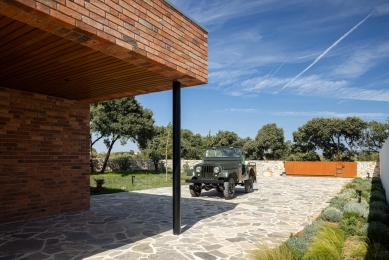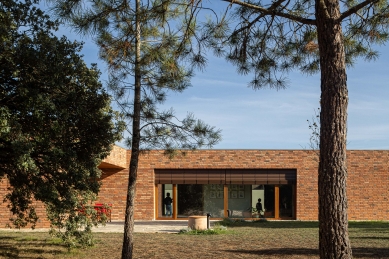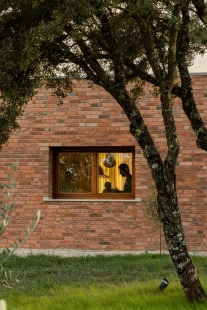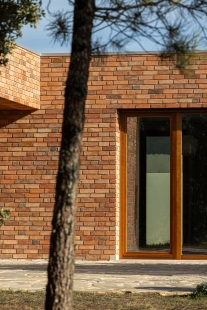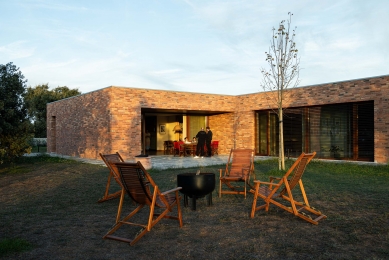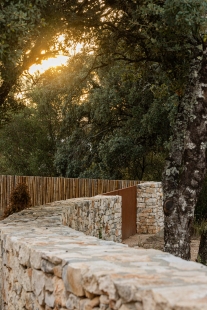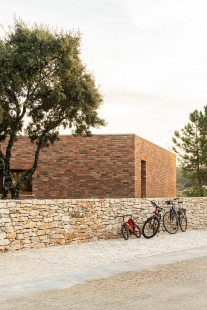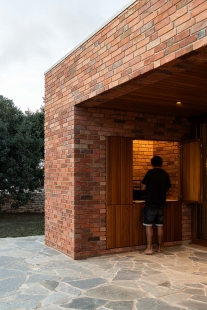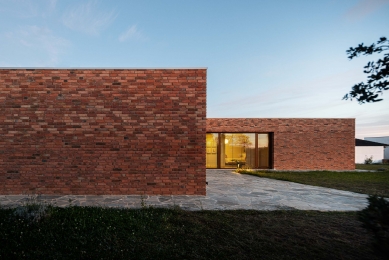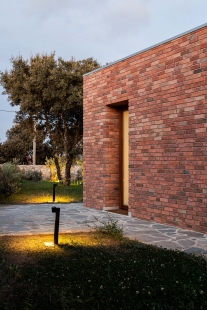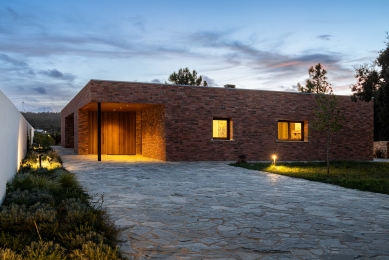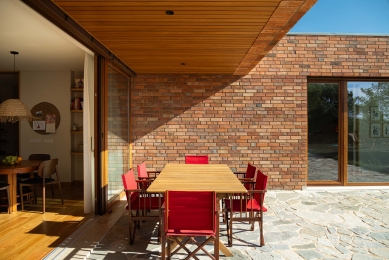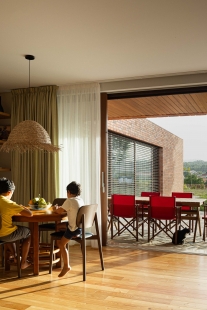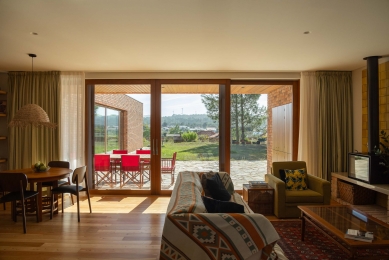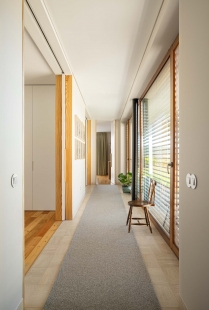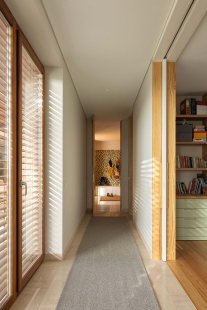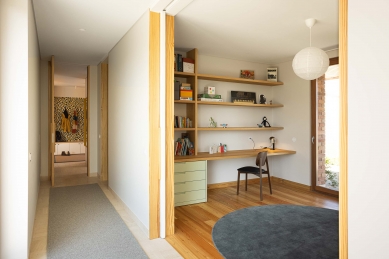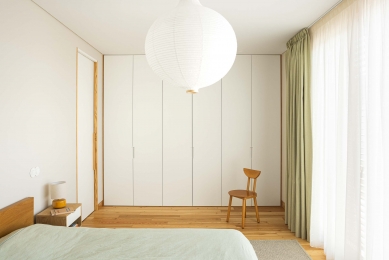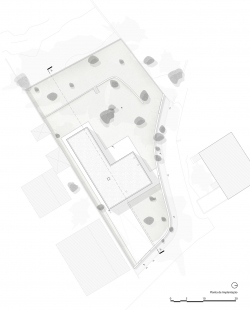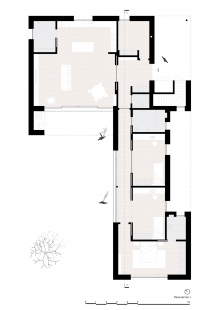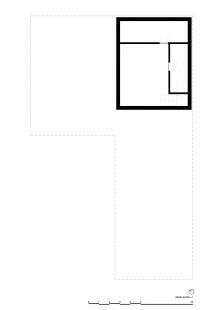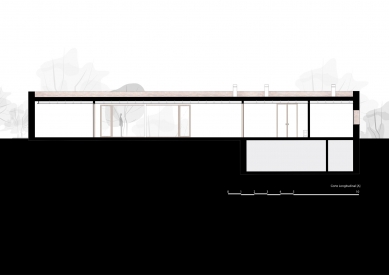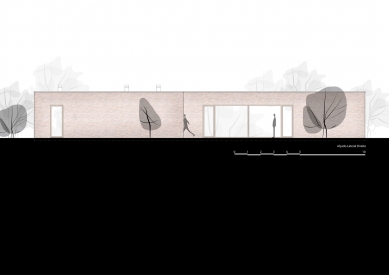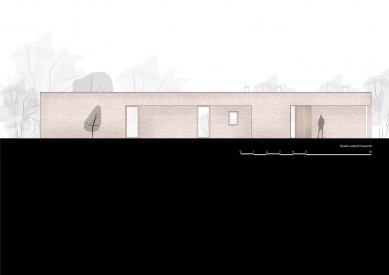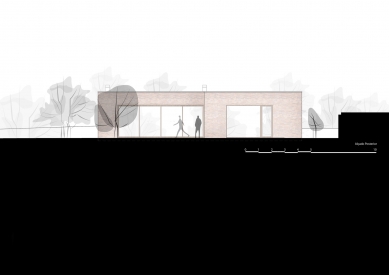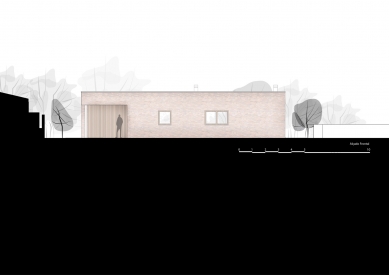
Lameira House

Located close to the city center of Fátima, but already integrated into an environment with fundamentally rural characteristics, the project of this single-family house appears as an intervention that has in its genesis respect for the surrounding natural landscape, as well as the characteristics of the land on which it is located, simultaneously seeking to enhance local materials.
The owners are a young couple, with two children. As one of the couple's members is an architect by training, from the beginning he was involved in the development of the project together with the design team, having brought the Lemke House by Ludwig Mies van der Rohe as inspiration and reference for the work. The project sought to respond to the premises established by the owners and the objectives relating to the daily experience intended for the home, with emphasis on the enhancement of natural light, the idea of continuity between indoor and outdoor spaces – ensuring their privacy –, spatial flexibility and the primacy of the use of natural and local materials.
Regarding the concept of spatial flexibility, it was intended that the children's rooms would function as versatile compartments, allowing them to be used both for retreat during rest or study hours, functioning as more enclosed spaces, but which could simultaneously be opened up in continuity with the social spaces of the house during the day and during playtime. This idea of versatility is materialized through the creation of large sliding panels, which allow these rooms to be opened almost to the full extent of one of their walls, in order to absorb the space of the corridor – which, in turn, relates, in a frank and direct way, to the garden through a large window.
As for materiality, the most differentiating character of this project is related to the fact that there was an increasingly less common opportunity to use artisanal and local materials and construction techniques, in contrast to the current scenario of a growing shortage of specialized labor and the consequent widespread use of industrialized and fully standardized materials. The use of handcrafted solid brick that covers the facades is the best example of this, with its manufacturer, already of advanced age, ending production after providing the necessary material for the construction of this house, which was already in its final stages with difficulty – which led the owner of the house and one of his sons to actively participate in the production process, so that with their help it was possible to reach the quantity necessary to carry out the work. Only in this way was it possible to obtain the desired result for the composition and texture of the facades, where each brick is a unique piece, with particular dimensions, textures and colors.
Through a closer look, it will be possible to discover a design object integrated into the east-facing facade, which was possible to incorporate into the brick cladding itself. This is the “Bee Brick”, designed as a nesting shelter for solitary bees, produced through the incorporation of recycled materials.
Although handcrafted brick is the most prominent material, this idea of proximity to local materials and techniques extended to the majority of the work. The hand-laid stone walls that enclose the land were made with stone reused from centuries-old walls in ruins nearby. During the work, the owner learned that these walls would be demolished and, together with the artisans, they went to the site and selected and transported the stone needed to build the new walls of the house. The window frames and external ceilings in natural wood were also made by local artisans and the stonework used in the work is of local origin, from the quarries in Fátima. The different textures of these materials are highlighted, applied using artisanal techniques, giving the work a tactile character.
The house is essentially composed of a simple volume, in the shape of an “L”, from which the voids corresponding to the exterior covered spaces are removed, being located on the land in order to safeguard a harmonious integration with the existing afforestation – composed of holm oaks, olive trees and pine trees – providing a balance between comfort, privacy and respect for the environment. This volume is positioned on a flat platform, at the highest level of the land and close to the public access road, to the east, ensuring greater privacy on the route approaching the main entrance, its main elevation denoting this idea of greater closure, with smaller openings, in contrast to the west-facing fronts, which open generously onto the garden area, through large openings, which allow to create a notion of continuity between internal and external spaces and for natural light to spread, in a controlled manner, providing a bright and welcoming environment.
As for the internal distribution of the house, the program is essentially developed in two distinct wings, demarcated by the entrance atrium: the first corresponds to the predominantly common and social spaces of the house, such as the living room, dining room and kitchen in open space, laundry, office and also covered outdoor areas; while the other wing contains private spaces, such as bedrooms and sanitary facilities. There is also a basement area, with access from the outside, for storage and technical areas.
The owners are a young couple, with two children. As one of the couple's members is an architect by training, from the beginning he was involved in the development of the project together with the design team, having brought the Lemke House by Ludwig Mies van der Rohe as inspiration and reference for the work. The project sought to respond to the premises established by the owners and the objectives relating to the daily experience intended for the home, with emphasis on the enhancement of natural light, the idea of continuity between indoor and outdoor spaces – ensuring their privacy –, spatial flexibility and the primacy of the use of natural and local materials.
Regarding the concept of spatial flexibility, it was intended that the children's rooms would function as versatile compartments, allowing them to be used both for retreat during rest or study hours, functioning as more enclosed spaces, but which could simultaneously be opened up in continuity with the social spaces of the house during the day and during playtime. This idea of versatility is materialized through the creation of large sliding panels, which allow these rooms to be opened almost to the full extent of one of their walls, in order to absorb the space of the corridor – which, in turn, relates, in a frank and direct way, to the garden through a large window.
As for materiality, the most differentiating character of this project is related to the fact that there was an increasingly less common opportunity to use artisanal and local materials and construction techniques, in contrast to the current scenario of a growing shortage of specialized labor and the consequent widespread use of industrialized and fully standardized materials. The use of handcrafted solid brick that covers the facades is the best example of this, with its manufacturer, already of advanced age, ending production after providing the necessary material for the construction of this house, which was already in its final stages with difficulty – which led the owner of the house and one of his sons to actively participate in the production process, so that with their help it was possible to reach the quantity necessary to carry out the work. Only in this way was it possible to obtain the desired result for the composition and texture of the facades, where each brick is a unique piece, with particular dimensions, textures and colors.
Through a closer look, it will be possible to discover a design object integrated into the east-facing facade, which was possible to incorporate into the brick cladding itself. This is the “Bee Brick”, designed as a nesting shelter for solitary bees, produced through the incorporation of recycled materials.
Although handcrafted brick is the most prominent material, this idea of proximity to local materials and techniques extended to the majority of the work. The hand-laid stone walls that enclose the land were made with stone reused from centuries-old walls in ruins nearby. During the work, the owner learned that these walls would be demolished and, together with the artisans, they went to the site and selected and transported the stone needed to build the new walls of the house. The window frames and external ceilings in natural wood were also made by local artisans and the stonework used in the work is of local origin, from the quarries in Fátima. The different textures of these materials are highlighted, applied using artisanal techniques, giving the work a tactile character.
The house is essentially composed of a simple volume, in the shape of an “L”, from which the voids corresponding to the exterior covered spaces are removed, being located on the land in order to safeguard a harmonious integration with the existing afforestation – composed of holm oaks, olive trees and pine trees – providing a balance between comfort, privacy and respect for the environment. This volume is positioned on a flat platform, at the highest level of the land and close to the public access road, to the east, ensuring greater privacy on the route approaching the main entrance, its main elevation denoting this idea of greater closure, with smaller openings, in contrast to the west-facing fronts, which open generously onto the garden area, through large openings, which allow to create a notion of continuity between internal and external spaces and for natural light to spread, in a controlled manner, providing a bright and welcoming environment.
As for the internal distribution of the house, the program is essentially developed in two distinct wings, demarcated by the entrance atrium: the first corresponds to the predominantly common and social spaces of the house, such as the living room, dining room and kitchen in open space, laundry, office and also covered outdoor areas; while the other wing contains private spaces, such as bedrooms and sanitary facilities. There is also a basement area, with access from the outside, for storage and technical areas.
João Pedro Pedrosa – Arquitectos
0 comments
add comment


